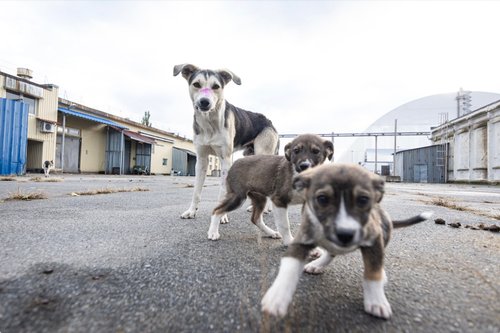Lights, camera, clean up your act: how movies try to go green
13. 10. 2022
4 min.


Ula Chrobak is a freelance journalist based in Nevada. You can see more of her work at https://www.ulachrobak.com/
Blockbuster films harbor a dirty secret. Behind the spectacle of the screen is a less dazzling reality: large productions tend to be polluting, to have a hefty carbon footprint and to create shocking levels of waste. The problem lies with the materials used to build sets, the excess of power required for stages and the many miles driven by the crew, among other things. These all have a sizable impact on the environment. Now, however, productions are turning to sustainability consultants to help clean up their act.
Making movies can be a dirty business. The average blockbuster film emits 3,370 metric tons of carbon dioxide, according to Zena Harris, the president of Green Spark Group and founder of the Sustainability Production Forum, citing numbers from a 2021 report by the Sustainable Production Alliance (SPA). That’s a lot in any language. “In order to sequester that much, you’d have to plant something like 55,000 trees and have them grow for 10 years,” she explains.
A 2020 analysis commissioned by the British Film Institute came to similar conclusions. It says that it would take a 3,709-acre forest a year to absorb the carbon emissions generated by the average blockbuster in production and the energy used would be enough to light up Times Square for five days. That’s based on data from 19 films with budgets of more than $70 million. Unnecessary waste generated during one of those productions, on average, weighs more than 300 blue whales. Transportation was the largest source of carbon emissions in these big productions, followed by electricity and gas use, and then diesel generators.
Increasingly, industry executives are making commitments to address these issues. Several major studios and streaming platforms — including Disney, Netflix, and Sony Pictures Entertainment — are a part of the Sustainable Production Alliance. In 2010, the alliance launched the Green Production Guide, a resource to help productions to calculate and reduce their footprints. Netflix has also separately committed to reducing emissions in line with the Paris Climate Agreement. “We’re seeing a lot more studios and production companies wanting to have a sustainability presence,” says Jennifer Sandoval, the director of services at Earth Angel, a production sustainability consulting company. “You can’t really just ignore how you’re making films anymore,” she says.
While making a commitment is a key step, implementing change is much harder. A 2006 report prepared by UCLA Institute of the Environment points out that the industry is highly decentralized and relies on a vast network of actors, set designers, videographers and other professionals who operate as independent contractors hired for the duration of a production. That hasn’t changed in the intervening years. So without greater coordination, it can be hard to implement sustainability practices.
That’s where the growing field of sustainability consulting comes in. More and more, studios and producers are hiring consultants such as Sandoval and Harris who help to plan, implement and monitor environmentally-friendly practices. Their main focuses include fuel use, energy consumption, and waste.
To tackle the various sources of emissions and trash, consultants like to get involved early – often four to six weeks before shooting begins. “If we engage really early on, we have the opportunity to read the scripts, have conversations about this scene and that scene, and really dive into the inquiry process,” says Harris.
When building sustainability into a production, Louise Smith, director of Neptune Environmental Solutions, connects with several teams. She makes sure the accounting office is set up to track everything that could have a carbon footprint, such as all the equipment rentals and travel involved. Smith also works with the transportation, electrical and locations teams to help identify vendors that meet more stringent environmental standards such as a company that provides LED-based illumination. LED lights offer good light while lasting longer and are more durable than other lighting types including incandescent bulbs.
Once the production is underway, the single largest source of carbon emissions is fuel use, with transportation — air and road — accounting for most of that. Finding ways to reduce trips, to carpool, and to rent hybrid or electric vehicles can help.
Diesel generators also burn a lot of fuel while filming, creating carbon emissions and polluting the air. The easiest way to avoid these dirty power sources is to plug into the grid when possible, says Harris, which might mean considering grid availability during location scouting. Where that’s not possible, simple actions such as limiting runtime and sizing generators appropriately can work as generators are less efficient when used at lower capacity, for example. But even small changes can make a difference, adds Harris, such as having vendors offer vegetarian meals a couple times a week.
Big productions also use large amounts of plywood, plastic and other materials to build sets, props and costumes. Much of this is then dumped when the project wraps up. This is the case even when houses have been built for the production, according to Sandoval. “You can have a million pounds of construction waste at the end, and typically that [often goes] into landfill,” she says.
Other types of waste include food waste, left-over appliances or temporary kitchens. Handling that requires coordinating with a variety of organizations and identifying what recycling resources are available in the area.
Some materials are even linked to deforestation. Set builders love to use lauan, a cheap and light tropical wood, but rainforests have been chopped down to grow it. At a minimum, sustainability consultants push productions to purchase Forest Stewardship Council-certified wood or wood alternatives such as RevolutionPly. Getting the industry to adopt certified wood is just the first step, says Harris. The goal instead, the consultants say, is to design waste out of the system. This includes asking such questions as, “How can we build for deconstruction? Can we use screws instead of nails? Can we build things at standard sizing, so that it’s more likely that it’ll be used by another production?” according to Sandoval.
The existing infrastructure can limit just how sustainable a production can be, however. Smith is working with film organizations in London to fix that and she was part of an effort to study the most popular filming sites in the city. The team identified spots such as Victoria Park where installing an electrical cabinet would help to reap benefits such as lower pollution and emissions. Not only can future productions plug in at the park and source renewable power, events like concerts can also use it.
While films and TV series are not the largest emitters of carbon emissions, the industry has an important role to play — and not only in cleaning up its actions behind the scenes. In the same way that movies once normalized smoking by showing attractive actors with cigarettes dangling from their mouths, they can influence how audiences perceive environmental practices. “There’s the on-screen, and then there’s the behind-the-scenes,” says Sandoval. “Together, I think the film industry is in a powerful position to really make a change.”
Photo: Welcome to the Jungle
Follow Welcome to the Jungle on Facebook, LinkedIn, and Instagram, and subscribe to our newsletter to get our latest articles every day!

Viac inšpirácie: Working for the planet

The ‘passion tax’ animal welfare workers are expected to pay
Workers in welfare and rescue organizations, zoos, and veterinary say their love for animals is often exploited, leading to burnout and high turnover
04. 3. 2024

Healthcare industry emissions are a problem, but doctors can help
Medical professionals are working to address the greenhouse gas impact of their industry, from changing clinic practices to...
05. 2. 2024

Here’s how to make work safer as climate change worsens heat stress
As though climate change didn't pose enough challenges, rising temperatures are also sapping workers' productivity and health
23. 8. 2023

Sorting the green from the greenwashed: How sustainable is your employer?
A majority of Americans care about corporate sustainability. But how do you know if your company is walking its climate talk?
27. 3. 2023

The wild dogs of Chernobyl: the story of the pups born on radioactive wasteland
What happened to the animals left behind after the nuclear disaster in Ukraine, and who are the people helping them?
16. 11. 2022
Novinky, ktoré to vyriešia
Chcete držať krok s najnovšími článkami? Dvakrát týždenne môžete do svojej poštovej schránky dostávať zaujímavé príbehy, ponuky na práce a ďalšie tipy.

Hľadáte svoju ďalšiu pracovnú príležitosť?
Viac ako 200 000 kandidátov našlo prácu s Welcome to the Jungle
Preskúmať pracovné miesta